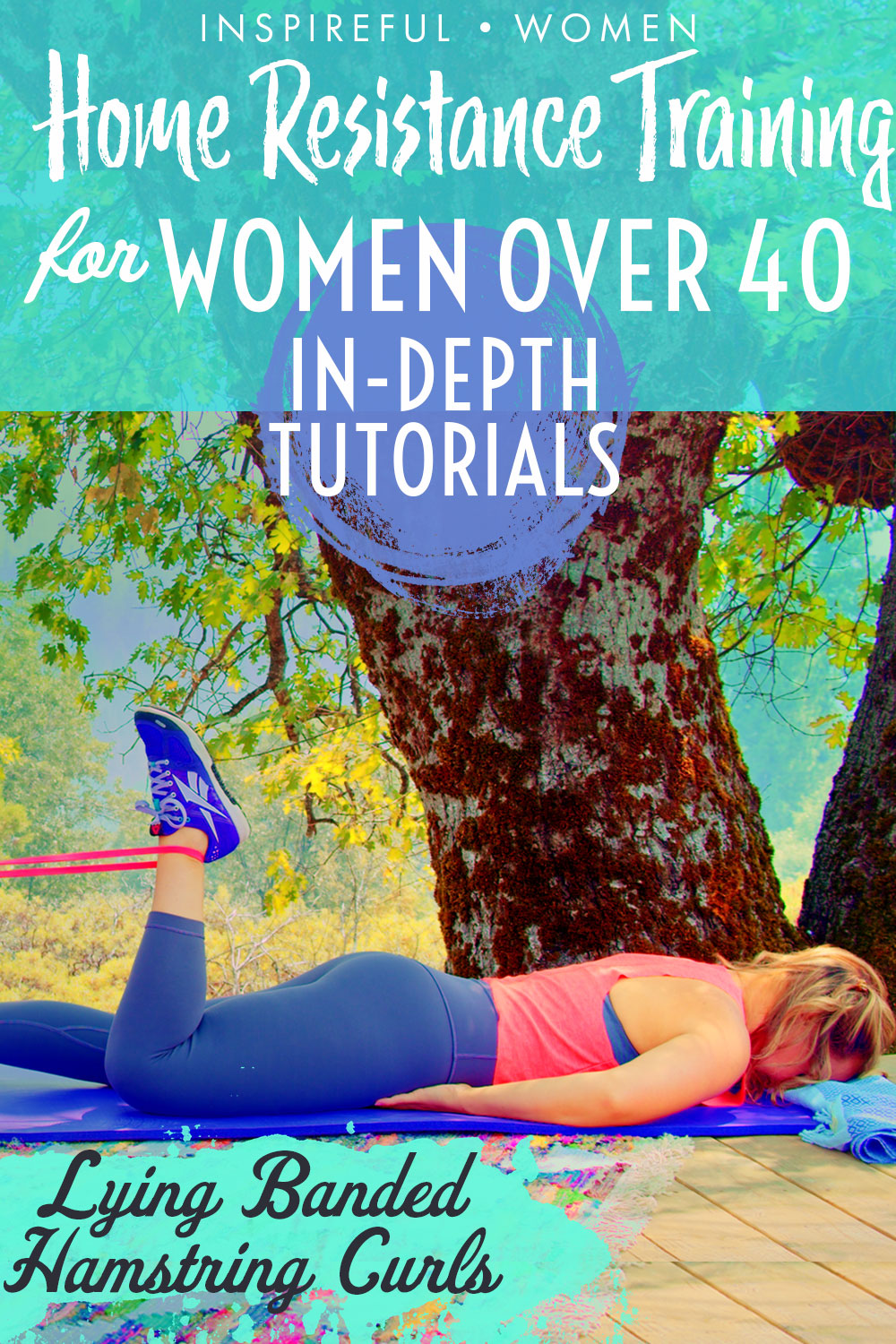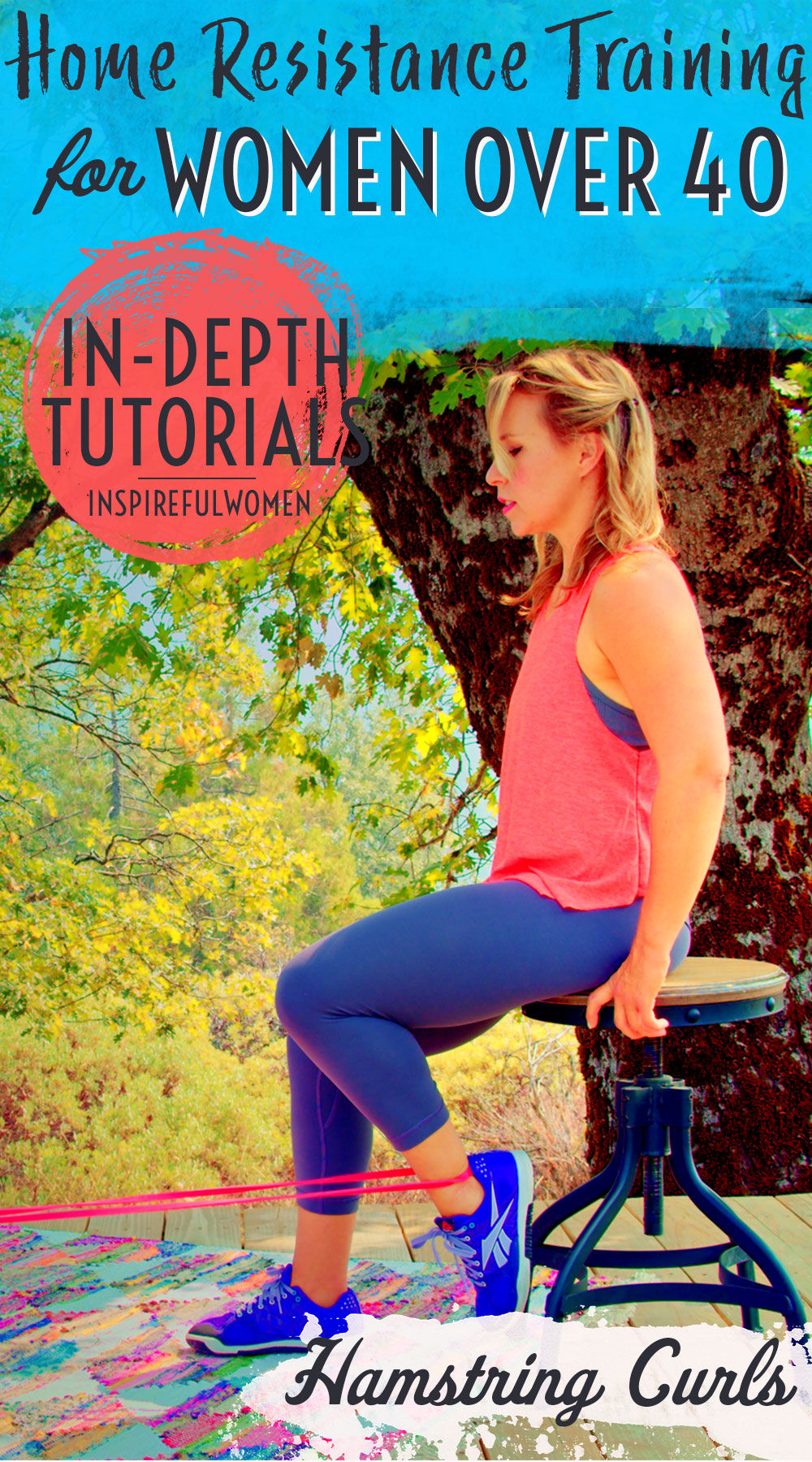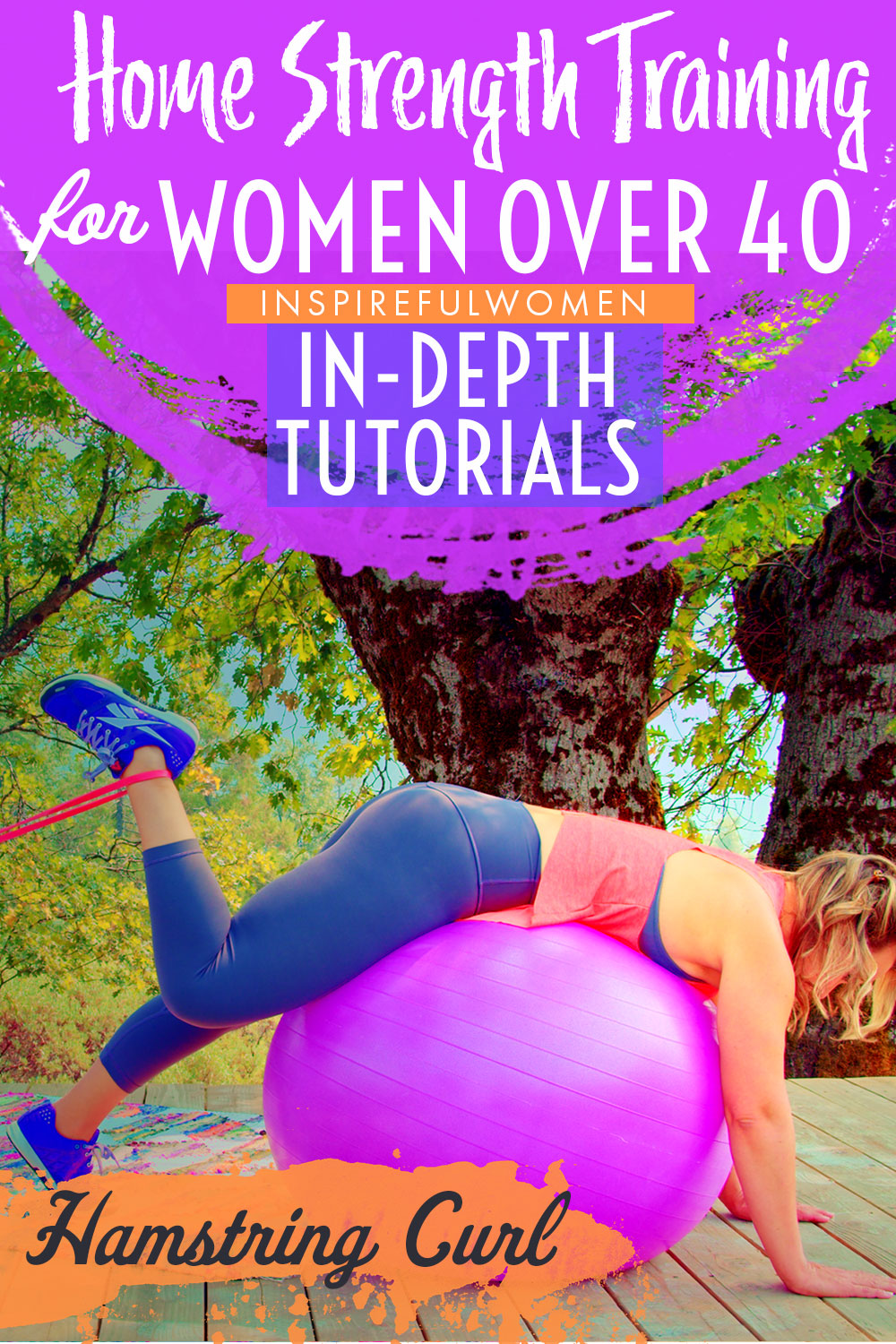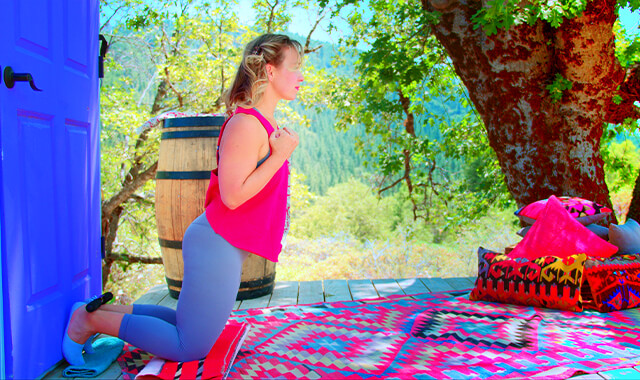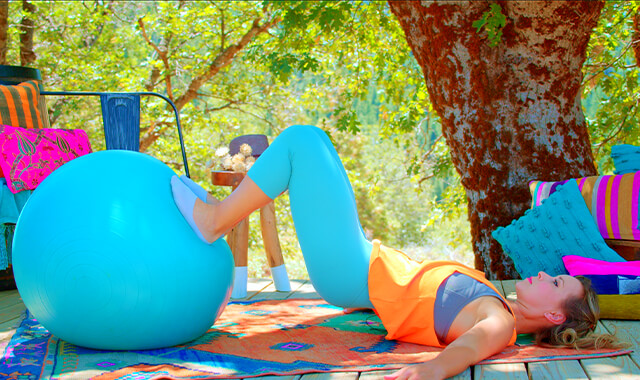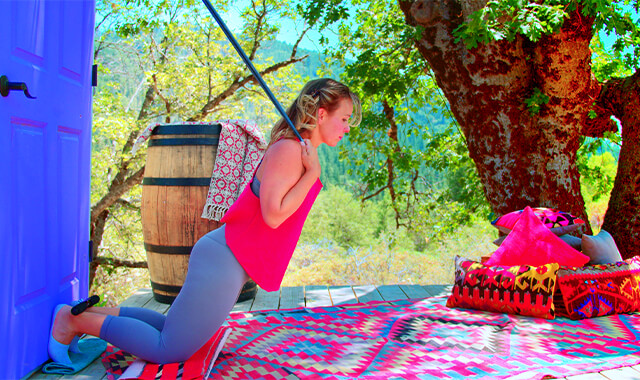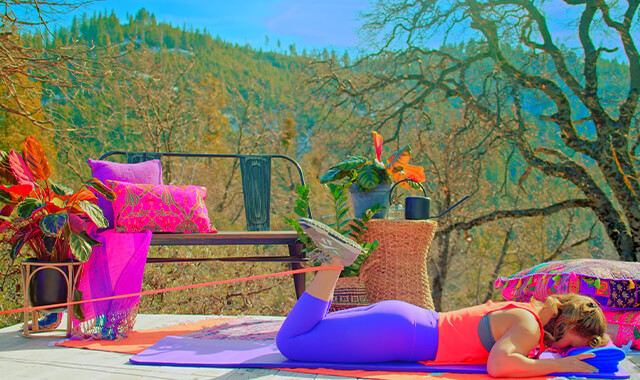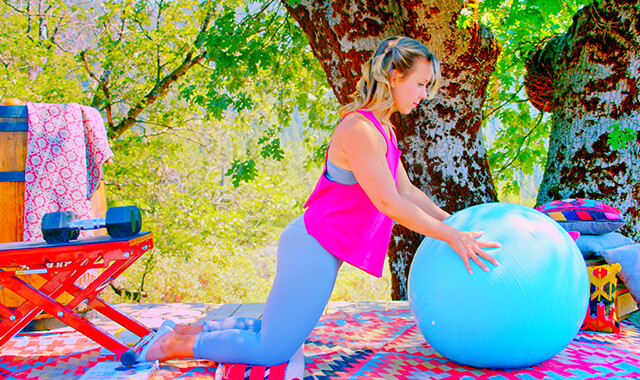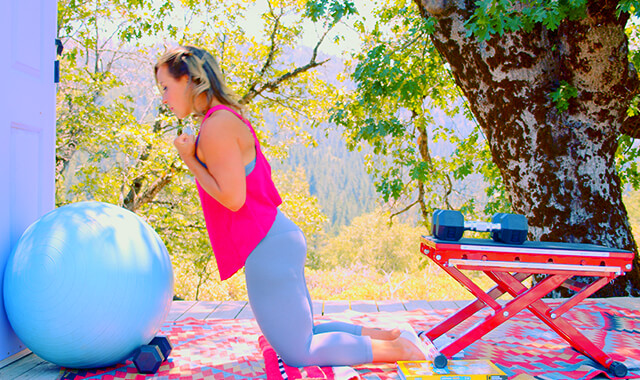Band Lying Hamstring Curl
How to Do Floor Hamstring Leg Curls - Resistance Band - No Machine | In-Depth Guide [VISUAL LEARNERS] Beginner
Proper Form, Common Mistakes, Variations + Easier & Harder | Home Resistance Training
WHAT DO YOU WANT TO SEE?
QUICK DEMO
QUICK DEMO
MUSCLES THIS WORKS
MUSCLES
MAIN MUSCLES WORKED IN THE LYING HAMSTRING CURL
HAMSTRINGS
OTHER MUSCLES WORKED:
- GLUTES (gluteus maximus)
- CALVES (gastrocnemius)
- LOW BACK MUSCLES (lumbar)
- ABS (abdominals)
WHAT WE'RE DOING TODAY
WHAT & WHY
BENEFITS OF TRAINING YOUR HAMSTRING MUSCLES
WHAT
WHAT WE'RE DOING TODAY
Other names for this exercise: Prone hamstring curl with resistance band
It is not easy to find effective exercises that focus on the hamstrings that you can do at home, since the hamstring muscles are so strong & we often don't have access to equipment or positioning that makes it possible to fully fatigue these muscles at home. But this is one of them!
ALL WE'RE DOING IS:
Bend your knee. K, now unbend it. Done.
The lying hamstring curl works the hamstring muscles while lying on your stomach - face down, this is also called the prone position (I love laying down exercises don't you?), using a resistance band mounted low to the ground to work the hamstring muscles.
The hamstring can move the leg in two ways - it helps to move the thigh back (extension) and it also bends the knee. In the prone/face down position, the hip does not move and the focus is on using the hamstring muscles to bend the knee. You can try to isolate the muscle and really work on strength and control.
This position allows for working the middle and lower portions of the hamstrings that act to bend the knee (knee flexion) without actively extending the hip.
Who cares if the hip joint is creased or isn't? What's the dif?
When the hamstring is in neutral it will be stronger when bending the knee, so a nice way to work the hamstring muscles.
The use of an elastic band facilitates training the muscle eccentrically (the muscle being lengthened under load/resistance, a great way to train muscles.
LOWERING LEG/UNBENDING KNEE JUST AS IMPORTANT IN THIS EXERCISE
The hamstrings don't just bend the knee or move the leg back behind the body.
The hamstrings also do a lot of work just slowing down the movement of the leg FORWARD by the quadriceps (the quads pull the leg forward forward by flexing the hip & straightening the knee). More on the quads + hamstrings connection in the why area, but for now:
The hamstring has to counter the action of the quadriceps by acting as a brake to slow down the movement. This exercise helps to work to the ability to control the movement as the knee straightens.
It is important to know that this part of the exercise, when the band is pulling the foot back down to the ground, is as important as the first part of the exercise - when you are squeezing the heel towards your bottom. Strive for very smooth control on the way down - the lower leg (foot) should not wobble in or out as the knee is straightened to the starting position. Think of your hamstring muscles controlling the lowering, rather than just letting the lower leg fall back down.
WHY BOTHER DOING IT?
WHY
WHY DO WE EVEN CARE?
Why do this particular movement?
CREATE MUSCLE BALANCE WITH THE QUADS
The most important job of the hamstrings is to work in coordination with the quadriceps (muscles on the front of the thigh). Together they (hams & quads) control the movement of the leg, protect the knee from impact, and stabilize the knee.
These 2 muscle groups are antagonists - this means that they do opposing actions (ie hamstrings bend the knee, quads straighten knee. Hamstrings pull leg behind body, quads pull leg in front of body). The body is full of pairs of antagonists - the muscles usually lie on opposite sides of a bone and they move the joint in opposite directions - a common example is the biceps of the arm - it bends the elbow, and the triceps which straighten the elbow. Even though antagonists have opposing actions, they work together to control movement and to stabilize the joint. When one of the pair of muscles is disproportionately stronger than the other, the weaker of the two is at an increased risk for injury.
Many people have quadriceps muscles that are much stronger than their hamstrings. It is common and natural for the quads to be stronger - about 30 -50 percent stronger than the hamstrings, but when they become more than 50 percent stronger, damage to the muscles or joints can occur. Unfortunately, most people do more exercises for their quads than they do their hamstrings, creating an imbalance between the two. This can happen without you even knowing it - many exercises like lunges and squats will end up just training the quads more.
It is important to include exercises that specifically train the hamstrings to help prevent or correct an imbalance.
SPECIAL FOCUS ON MUSCLES THAT ONLY BEND THE KNEE
This hamstring exercise does not involve moving the thigh back (thigh remains still while lying down), so it really concentrates on the function of bending the knee without any movement at the hip. The short head of the biceps femoris muscle is one part of one of the hamstring muscles that only bends the knee and does not help to pull the thigh back. The prone hamstring curl helps to target the short head of the biceps femoris. Exercises that involve both hip extension and knee flexion - for example stability ball hamstring curls, or hamstring sliders, make it difficult to tell if you are activating the short head of the biceps.
EVERYDAY LIFE
EVERYDAY LIFE
MUSCLE FUNCTION
HOW WE USE OUR HAMSTRINGS IN EVERYDAY LIFE
If you'll care to have a look-see below, you'll find that we use our hamstrings in a ton of basic everyday activities.
1. BEND THE KNEE (aka flex the knee)
- Pushing the elevated leg rest of a recliner down
- Scooting a chair in to the table
- Pulling your foot back to tie your shoe
- Bending your knee to get into position to kick a ball
2.PULLS THE LEG BACK (aka extends the hip)
All the hamstrings except for the short head of the biceps femoris do this - it does not cross the hip joint.
- Running up hills
- Walking up stairs
- Getting up from sitting
- Getting up from the floor
- Walking up - especially up hills
- Moving your leg back to kick a ball
3. CONTROLS MOVEMENT OF LEG
Works with the quadriceps to control the movement of the leg
-
- Walking
- Running
- Jumping
- Kicking
- Squatting
4. WORKS WITH QUADS TO PROTECT KNEE & HIP JOINTS
Works with the quadriceps to keep the knee and hip stable to protect the joints from damage during standing and moving
- Standing
- Balancing
- Standing on a ladder with the weight on one leg to reach for painting/window washing
- Walking across a log
- Jumping
- Running
- Going up and down stairs
HOW TO DO THE EXERCISE
LOOKS
HOW HAMSTRING CURLS SHAPE OUR BODY
Tones and builds the muscles of the back of the thighs, which creates a beautiful curvy shape to the back of the legs. It's 2021 ladies, CURVES ARE COOL AND IN! And dontcha forget it!
This also counterbalances the bulk of well developed quadriceps.
PROPER FORM
PROPER FORM:LYING BANDED HAMSTRING CURLS
EQUIPMENT, SETS & REPS
EQUIPMENT:
Mat or bench to lie on, resistance band on a low anchor. You can also use ankle weights if you choose.
SUGGESTED STARTING WEIGHT FOR WOMEN:
Medium band if the form is good, the hamstrings are big and strong.
Note: I had to start with a light band and work up. Also, always start with low resistance for a workout to warm up your hamstrings so you don't get a cramp.
SETS & REPS:
2 sets of eight, must fatigue the muscle but maintain good form. 3 times per week.
PACE:
The hamstrings need to be worked eccentrically - they are decelerators. Do not swing leg or use momentum, slow controlled up with squeeze at end of the range then lower slowly with no knee wobble.
BODY POSITION
BODY POSITION FOR LYING BANDED HAMSTRING CURLS
BAND POSITION: Anchor the band about 4-6 inches from the floor. Anchor should be at a height that prevents the band from rolling up your shin.
BODY STANCE: Lie face down on a mat or bench. Put a towel roll (or hands) under your forehead so your neck is in a neutral position.
DISTANCE FROM BAND: You should be at a distance where the band is taut as soon as you begin bending your knee but you also want to be able to bend your knee at least 90 degrees.
FEET: Shoulder width apart. Loop the elastic band around the ankle (use a towel or piece of a cut pool noodle to avoid it digging in). Best to actually tie a loop in the band or it will slip off. The ankle should be relaxed. If you strongly dorsiflex the foot (bring toes towards shins) this would decrease the contribution of the calf muscle (gastrocnemius).
ARM POSITION: Relaxed, under forehead or under hip bones to monitor stability.
NECK: neutral
HOW TO DO
HOW TO DO LYING BANDED HAMSTRING LEG CURLS
CUE: Put your hands under your hip bones, do not let your pelvis rock side to side, or let your hip bone lift up (unweight from hand). Your core should be stable throughout.
- Lift your belly button towards your spine and gently push your pubic bone to the floor. Your glutes should be relaxed.
- Pull your heel towards your bottom slowly, keeping your pelvis still.
- At the end of the range squeeze the glute and hamstrings
- Lower your heel slowly, decelerating the pull of the band.
- Do all the reps on one leg, then straighten your knee and switch the band to the other foot.
HOW TO SAFELY GET OUT OF THE EXERCISE
Remove the resistance band using the other foot to get the band off your ankle, OR sit up and loosen tension on the band to remove it with your hands.
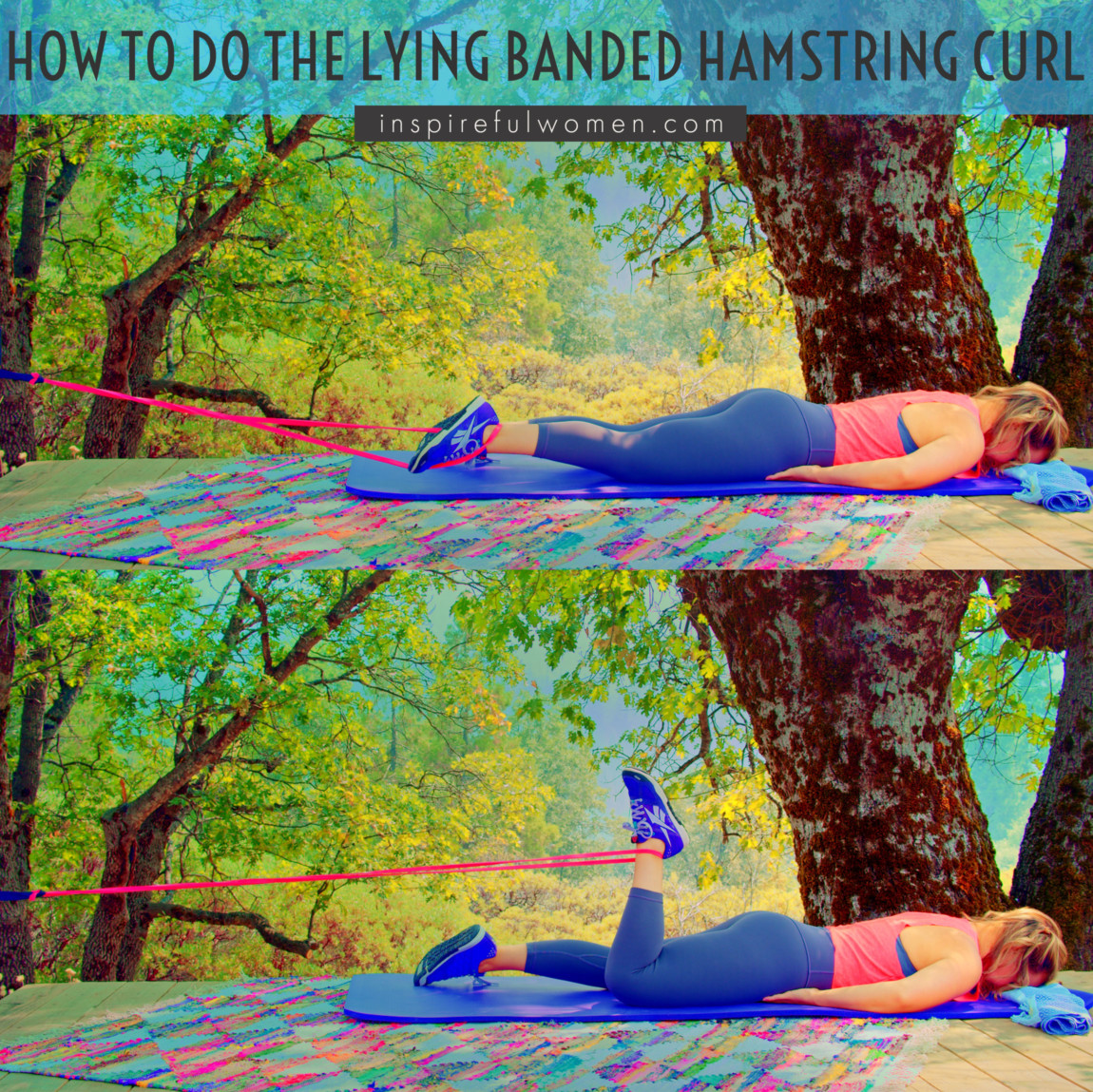
COMMON MISTAKES
COMMON MISTAKES
WHAT TO AVOID WITH LYING HAMSTRING CURLS
KEY TIP:
Guess what? Good news! Many avoids are the same for most movements. Once you learn the basics, there's really only a few extra avoids for each individual movement.
1. Avoid Working In A Limited Range Of Motion
Try to select a band resistance that allows you to fully bend your knee to at least 90 degrees, ideally beyond this where your heel is getting close to your bottom, the full range.
If you choose a band that's too strong, you won't be able to pull up very far which will not work the hamstrings effectively.

2. Avoid Lifting Your Hips
Keep the hips and pelvis still during the entire movement.
To do that, gently contract your abdominals and remember to keep them engaged as you bring your foot upwards.
It can be easy to forget about using our core muscles because our mind tends to be focused on our hamstrings, and that can cause our hips and pelvis to start moving and lifting off the ground.
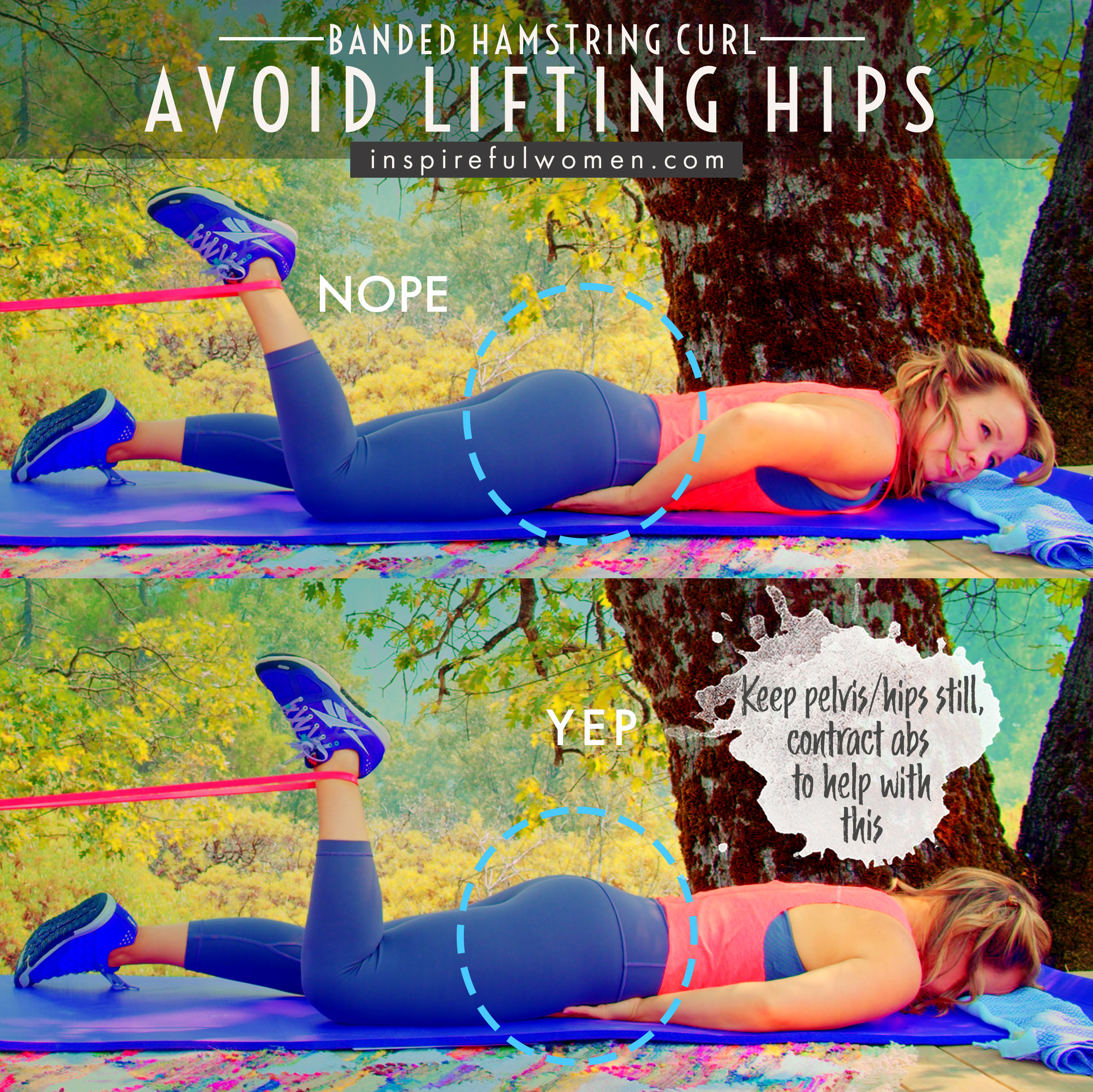
3. Avoid Momentum - Control the Motion
Avoid using momentum on the up or the down portion of the exercise.
Remember our goal is to fatigue the muscles we are working- in this case the hamstrings, and using momentum takes away from muscle activation.
We want our muscles doing the work to get our foot closer to our bottom, not momentum.
4. Avoid Tightening Glutes Before You Start Knee Bend
This is a little hard to explain, but the idea is to try to keep the glutes soft at the beginning of the exercise, so that we can try to really activate the lower portion of your hamstring area first (the goal is to get the short head of the biceps femoris involved).
If we contract our glutes right from the get-go, we may activate the portion of the hamstring higher up |(proximal portion). That's not bad or anything, but this movement gives us the opportunity to train the short head of the biceps femoris if we focus on this.
Try bending the knee using only the lower part of the hamstring. You can feel the bulge right at the middle of the hamstring, that is the short head.
Activate your abdominals but try to use your lower hamstrings first. Try to let the glutes kick in naturally, usually when the foot moves past being straight up in the air (lower leg perpendicular to the floor), and starts moving towards your bottom.
VARIATIONS
VARIATIONS
VARIATIONS OF LYING BANDED LEG CURLS
STABILITY BALL
Stability Ball Hamstring Curl
Doing this movement on a stability ball will increase activation of shoulder, neck (cervical) and hip stabilizers, nice to get more muscles involved and working during one exercise!
Plus who doesn't like to do awkward stuff like lay on a huge ball with a stretchy band attached to your ankle that's anchored to a door? Kind of makes you feel like you're the star of Cirque Du Soleil. Your family is bound to be impressed by your acrobatics. ;)-
How to do it: Lie over a stability ball with your belly button at the top of the ball and your hands on the floor, neck in neutral. The non-exercising foot on the floor to stabilize.
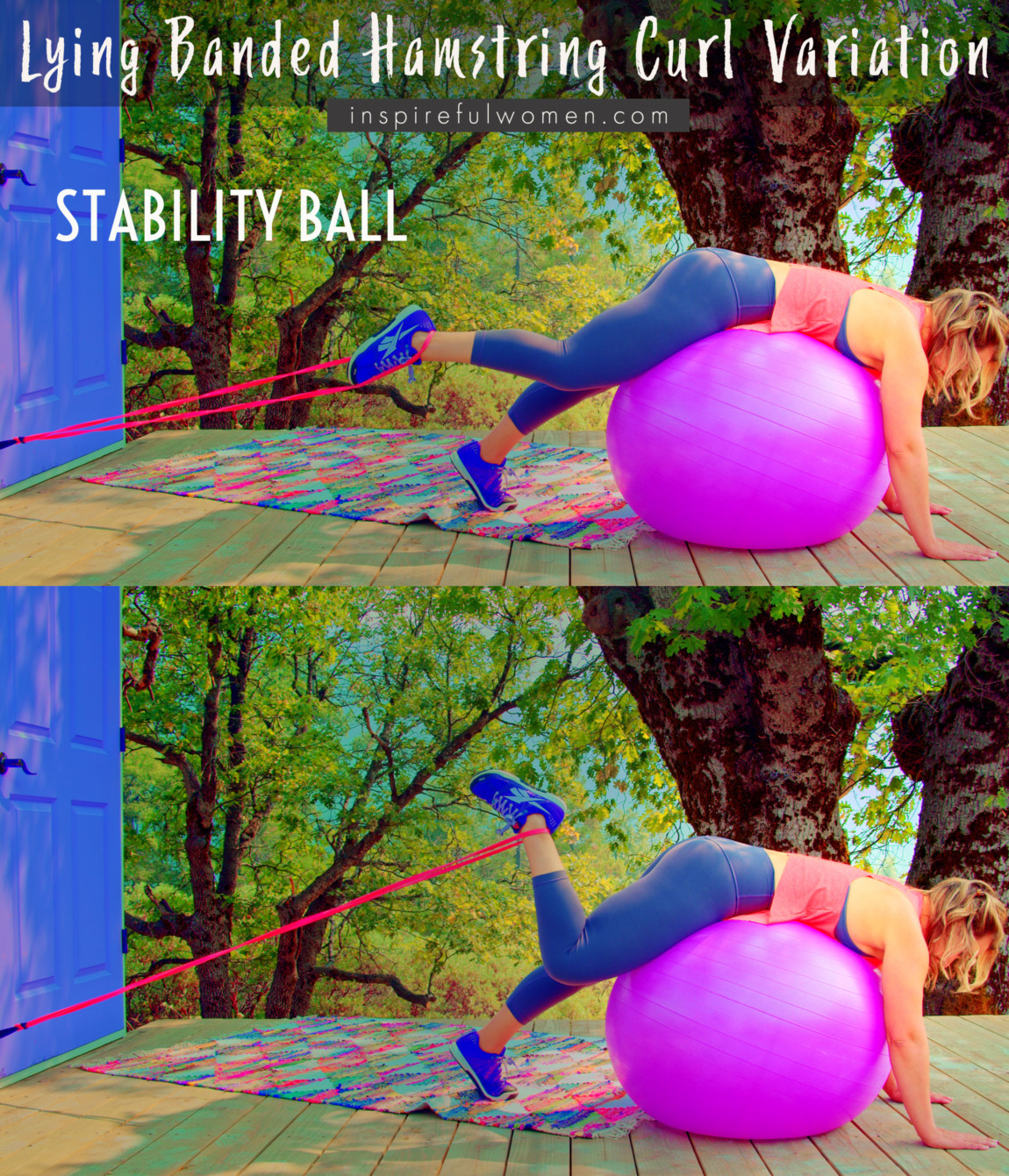
FLEXED FOOT
Flexed Foot Hamstring Curl
Actively flex (dorsiflex) your foot during the movement. This will decrease the involvement of the calf muscles & increase the hamstring activation as a result, without the calf muscles to help.
OTHER OPTIONS:
Toes in: Turning your toes inwards target the middle & inner part of your hamstrings (the semimembranosus & semitendinosus muscles)
Toes out: Turning the toes outward will target the outer hamstring area (the biceps femoris muscle).
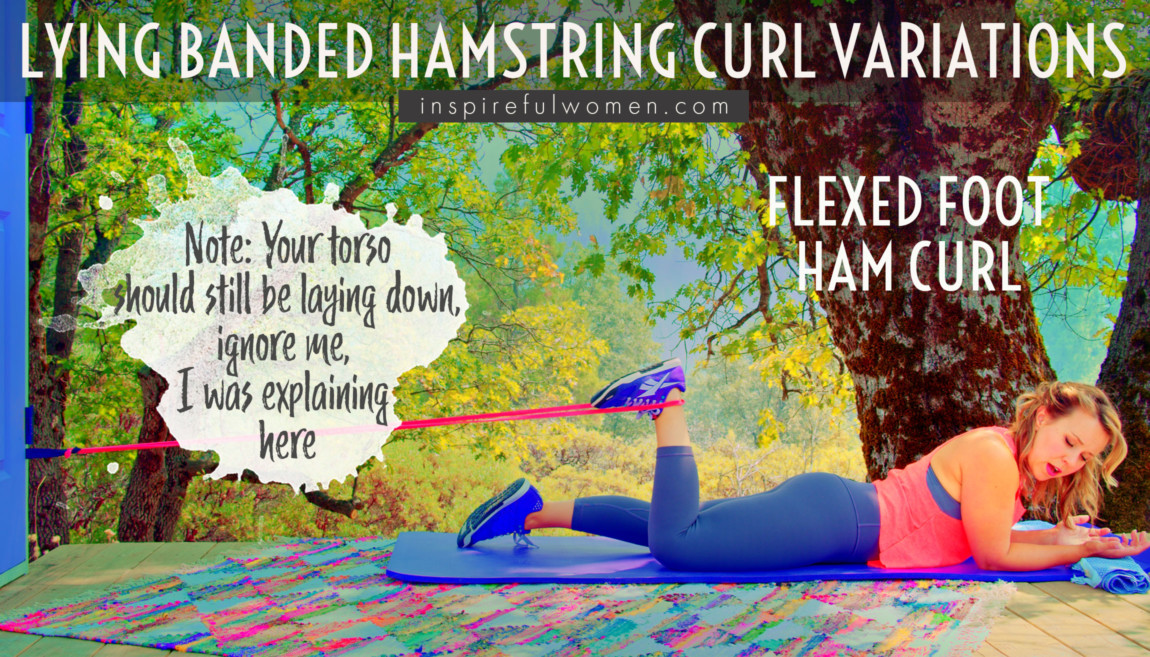
Forehead on Hands
Forehead Rests on Hands
If you don't have a towel handy to put under your forehead or don't want to bother getting one (totally me sometimes), you can simply rest your forehead on your hands.
When you do this, try to pay more attention to keeping your pelvis still as you will no longer have your hands under your hip bones as feedback.

MAKE IT HARDER
HARDER
MAKING THE LYING HAMSTRING CURL MORE CHALLENGING
STANDING
Standing Hamstring Curl
This can be done standing but it is more challenging because the hip will have to be actively held in extension (basically where there is no crease in your hip) and the standing leg will have to work isometrically to stabilize against the pull.
In trying this out, I am here to vouch for the fact that looking at it LOOKS easy and like it won't be a great exercise, but in reality it's super hard!
There are a few ways to do standing- in all of them the goal is to stand tall during the movement, not leaning over. If you want support in the movement where your hands are resting on something, you need to be set up so that you are not leaning over.
The main importance is that your working hip is not bent (flexed) so that you are working your glutes along with your hamstrings. The non-working hip can be a bit flexed in this position if it’s more comfortable.
You can use a door for support and loop the band on the door anchor made for resistance bands, placed on the hinge side of the door.
To be sure your hips are straight during the movement, you can actually be positioned right up to the table - so your hips are almost touching, this makes it easier to keep the hips straight.
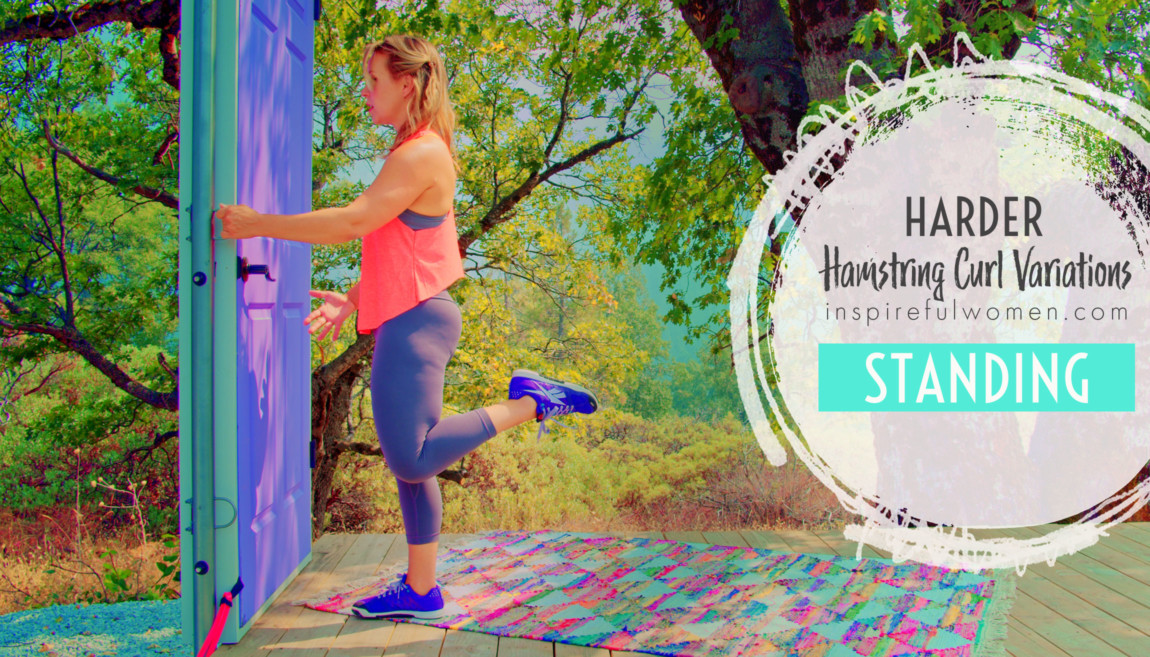
SLOW ECCENTRIC
Slow Eccentric Hamstring Curl
Slow down even further while you lowering your leg. You can count 5-10 seconds for lowering time for each rep.
This is called the eccentric component, where the muscle is actually lengthening under resistance, and this is an excellent way to build strength.
When doing this you will often find that you can't do as many reps for a set as for a normal lowering time OR you likely would need a lighter band to do the same number of reps because it's quite a bit more fatiguing to the muscle.
MAKE IT EASIER
EASIER
MAKE THE LYING HAMSTRING CURL MORE DOABLE
USE LIGHT THERAPY BAND
For many of us, our hamstrings are pretty untrained.
Even with all the years I spent at crossfit, once I started working out at home mindfully, doing different movements to make sure I was working all parts of my body, I found that my hamstrings were very weak in comparison to my quads and I also had a very poor mind-muscle connection with them.
So when I first started doing hamstring exercise I had to start with all the very easiest options and least resistance.
For this particular exercise, there is an even lighter weight resistance band called a therapy band that doesn't come in the standard loop band sets you buy online:
--Lightweight Therapy Loop Band--
Personally, I recommend getting this particular resistance band weight either way because it's great for many of the exercises we'll be doing.
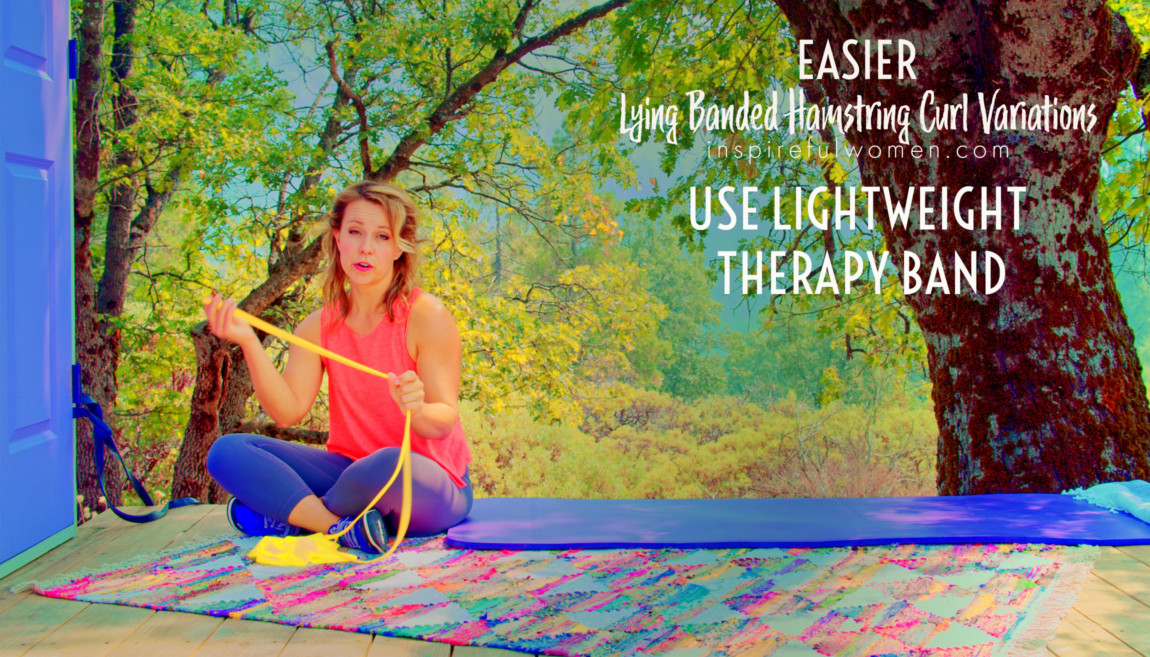
USE KNOTTED THERABAND
Use Knotted Theraband
If you don't have loop bands, or the loop bands you have are not the right resistance for you, you can take a piece of theraband and tie the ends around your anchor.
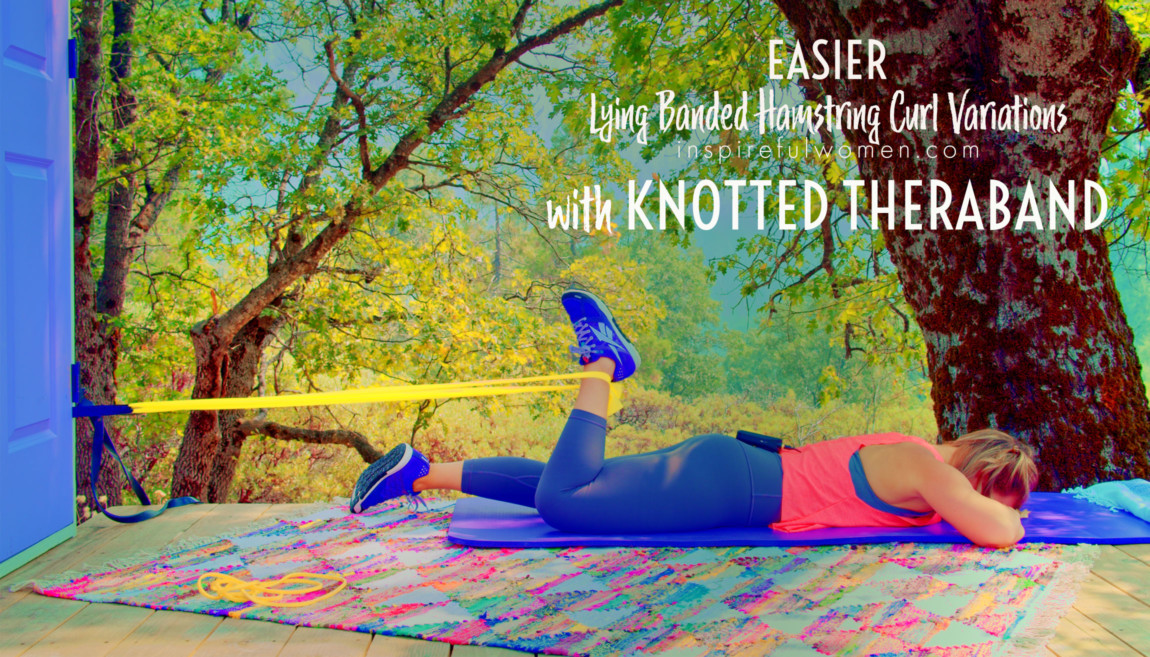
NO RESISTANCE
No Resistance Hamstring Curl
Just do the movement with your legs and focus on squeezing at the top.
As I mentioned, many of us have deconditioned hamstrings, myself included when I began, so even just doing the movement with no resistance while still thinking mentally about contracting your hamstring muscles as you bend your knee, and really squeezing at the top of the movement, I think you will find your hammies get a workout!
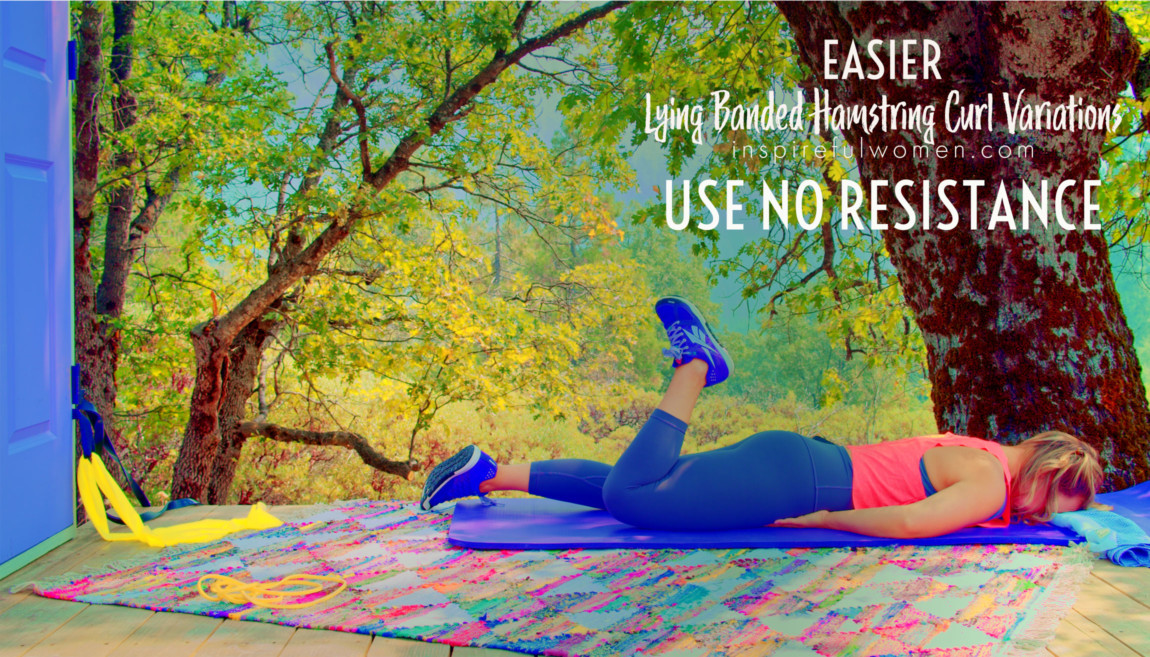
SEATED ON CHAIR
Seated Hamstring Curl
You can do this movement seated in a chair, however it's not the ideal way to do it because seated position will not produce glute activation along with the hamstrings.
The most heathy functional way train the hamstrings is together with the glutes.
However! If the other moves don't work for you, this is definitely completely a fine way. No guilt!
You will anchor the band low like usual, around 4" from the ground, and sit on a chair with the resistance band around your ankle. Start with the knee extended in front of you - the band ideally will already be taut in this position.
Bend your knee to pull your foot under the chair. The chair should be high enough so that the foot moves freely. If you need to lift the foot then the hip flexors will be activated which will inhibit any glute activation.
Question I had when doing this version: I wondered to myself if it mattered how much of my legs were sitting on the chair- ie should I sit with just the edge of my bottom on the seat? Is it bad if my hamstrings are all the way on the chair while doing this move?
Answer from Physical Therapist: As long as you can clear your foot and are sitting tall - no rounding forward of the back (called spinal flexion), it doesn’t really matter how much of your thigh is on or off the chair, so do what is comfortable for you. The pressure of the seat on the hamstring muscle wouldn’t be great enough to do anything like inhibit it from firing.
Leaning back is okay: This increases the hip extension a bit so may increase hamstring activation, probably minimally. It will work the back extensor and abdominals to hold the spine in neutral.
No leaning forward: Do no lean forward because it flexes the hip further preventing potentially preventing part of the hamstring from firing and all of the glute max.
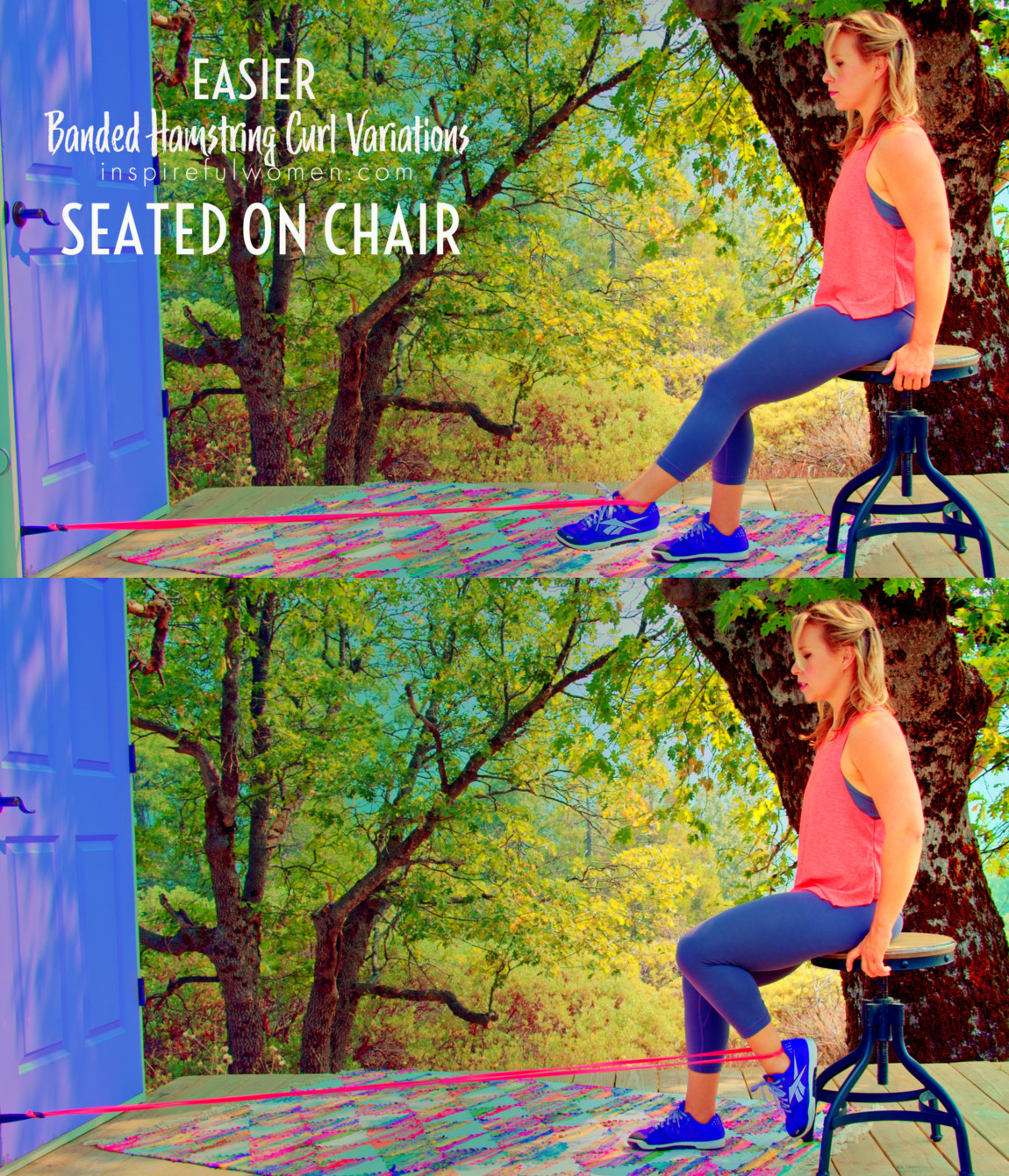
SCIENCY STUFF
SCIENCY STUFF
SPIFFILICIOUS FACTS ABOUT MUSCLES & MOVES
We know the hamstrings are somewhere on the back of our legs, and they don't involve pig meat. But what do they actually do? What function do they serve as we go about daiy life moving our body?
Our hamstrings are a group of three muscles:
- biceps femoris (outer ham)
- semitendinosus (middle ham)
- semimembranosus (inner ham) muscles.
MAIN THING HAMSTRINGS DO:
Together they work to
1. straighten the hip (extend the hip - this means essentially to go from a crease in hip to no crease and taking the thigh behind the body)
2. bend the knee (called flexing the knee)
Strong hamstrings are needed to balance the strength of the stronger quadriceps muscles. The main role of the hamstrings is to decelerate (slow) the action of the quadriceps in walking, running, and jumping. The hamstrings are active in running or walking up hills.
The muscles of the leg work together as shock absorbers and stabilizers of the knee - to prevent damage to the cartilage and soft tissues. The hamstrings protect the knee joint from impact and work to stabilize the knee.
PROTECTING KNEE JOINT THROUGH MUSCLE BALANCE
Many exercises focus on increasing the strength and size of the quads, so it is important to include exercises for the hamstrings so you do not create an imbalance around the knee joint.
The hamstring has to be strong enough so that the combination of all the muscles that cross the knee joint can control the motion to protect the joint surfaces and the ligaments (the hamstring plays a big role in protecting the anterior cruciate ligament from damage by decelerating the movement of the lower leg).
STRONGER POSITIONING TO WORK LOWER/MIDDLE PART OF HAMSTRINGS
Working the hamstrings with the hip in neutral (as this particular exercise does) allows you to work the lower portion of the hamstring that crosses the knee joint.
If the hip is bent then the hamstring is lengthened over the hip joint, so when the knee is extended the muscle will be in a weaked state (lengthened over both joints - so passive insufficiency). Muscles are their strongest in the middle of their range - not shortened or lengthened too much.
When the hip is in neutral, the hamstring will be stronger be able to bend the knee from a straight knee position because the hamstring is not lenghtened over the hip.
If the hip is in extension while the knee is flexed (like the donkey kick positionng) then the hamstring will be shortened over both joints - active insufficiency, and weaker - the gluteus maximus will kick in to do more of the hip extension, and the hamstring will flex the knee.
ALLLL MUSCLES & WHEN
ALL MUSCLES WORKING & WHEN DURING THE LYING HAMSTRING CURL
More than just your hamstrings are working in this movement, and I think it's so awesome to know just what muscles are working but also WHEN during the exercise.
- The core muscles act to stabilize the pelvis and back while the hamstrings act to bend the knees and pull the feet towards the bottom.
- The entire hamstring muscle works to bend the knee and pull the heels toward the bottom.
- With the hip in a neutral position the lower portions of the hamstring will be emphasized, especially the short head of the biceps femoris, as it does not cross the hip joint (cannot contribute to hip extension).
- As the knees approach full flexion (full bending) the upper portion of the hamstrings and the gluteus must contract to prevent hip flexion at the end of the range of motion.
- The hip flexion is usually due to lack of abdominal activation to stabilize the pelvis and/or hip flexor tightness.
PIN IT FOR LATER!
